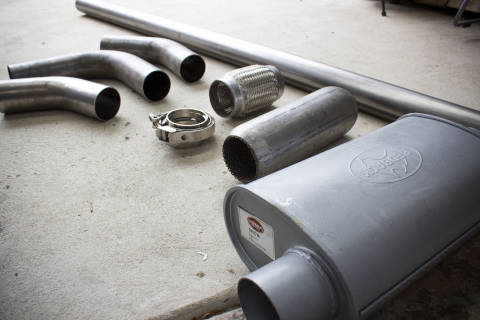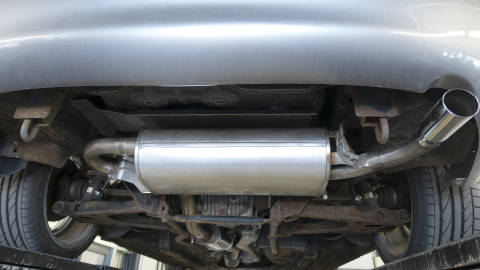Your Vehicle Exhaust System
The car exhaust system has multiple purposes. First, it muffles the sound of your car, lowering noise pollution. Secondly, it increases engine performance and fuel efficiency. And last but not least, it converts the otherwise harmful emissions after they leave the engine.
Muffler and Exhaust Inspection
The following will indicate that it is time for you to service the exhaust system:
- You smell burning, gasoline or exhaust fumes in the cabin
- You hear a loud motorcycle-like noise when the engine is running
- The sound of your muffler gets louder when you push the gas pedal
- Muffler or exhaust parts make a rattling noise

Often all that is needed to fix the noise is a new gasket. A gasket is a thin film which sits between the connecting pipes in the exhaust system and is used to seal the connection.
Sometimes the pipes are rusted through and require replacement. An exhaust system inspection will reveal where the issue resides. It's important to regularly inspect the exhaust system as the rubber hangers holding the components can wear out due to the harsh Canadian winters and salt exposure. Replacing the rubber hanger is really cheap compared to the damage that can occur when the rubbers can no longer properly support the exhaust parts, or worse, they fall off.

Muffler and Resonator
The muffler and resonator work together to reduce the sound of the car exhaust. A muffler consists of multiple chambers of different sizes which direct the sound waves into each other, causing them to cancel out.
Catalytic Converter
The catalytic converter converts some toxic gases that are produced due to partial combustion to cleaner forms of emissions. It converts nitrogen oxides, carbon monoxide, and hydrocarbons into oxygen, nitrogen, carbon dioxide, and water. Catalytic converters are required by law in order to prevent the toxic gasses from being released into the environment.
Oxygen Sensor
The oxygen sensor measures the exhaust gas moving through the exhaust pipes and sends the information to the car's computer, which in turn makes adjustments to maximize fuel efficiency and engine performance. Oxygen sensors have a limited lifespan, but replacing them is fairly cheap. When the oxygen sensor fails, it will cause the check engine light to illuminate.